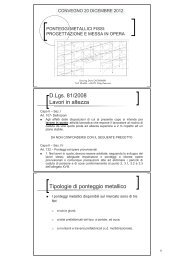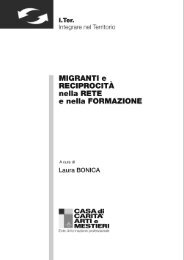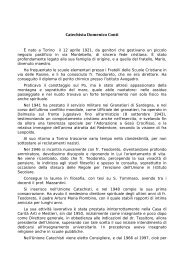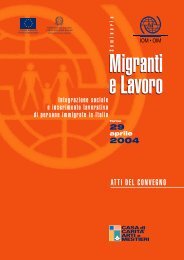Rapporto finale/ Final Report (ITA-ENG) - Casa di Carità Arti e Mestieri
Rapporto finale/ Final Report (ITA-ENG) - Casa di Carità Arti e Mestieri
Rapporto finale/ Final Report (ITA-ENG) - Casa di Carità Arti e Mestieri
You also want an ePaper? Increase the reach of your titles
YUMPU automatically turns print PDFs into web optimized ePapers that Google loves.
CONCLUDING REMARKS<br />
72<br />
The Cross Community Schools project shed light on the existence of <strong>di</strong>scrimination, preju<strong>di</strong>ces and<br />
stereotypes at <strong>di</strong>fferent levels in schools. At in<strong>di</strong>vidual level, because we all have stereotypes and<br />
preju<strong>di</strong>ces towards others that con<strong>di</strong>tion the way we interact with them a priori. At interpersonal<br />
level, because they emerge in relations between young people or groups of young people, often in<br />
conflict on the basis of gender, race, social class, etc. Discrimination also persists at institutional level,<br />
varying in intensity from country to country and context to context. This may be manifested as a refusal<br />
to acknowledge that <strong>di</strong>scrimination is a problem (as in the egalitarian French society, where it<br />
has led to nothing being done to address the issue) or a lack of fun<strong>di</strong>ng and action by the competent<br />
authorities.<br />
All these problems, at the various levels, have negative consequences on work in the classroom and<br />
frequently prevent the creation of cohesive and inclusive classes, thus making the work of teachers<br />
much harder.<br />
The Dialogue Spaces set up under the project were found to be a potentially effective and useful<br />
tool for overcoming these problems. This activity does, however, require careful investment of resources<br />
(not so much financial, but rather in terms of time and commitment) and much reflection<br />
on how best to implement it, in the light of the experience gained over the last two years.<br />
To that end, this Research <strong>Report</strong> sets out the main points for planning and managing activities<br />
aimed at effectively addressing the issue of stereotypes and intolerance. These range from the<br />
choice of topics through which to address the problem of inequality to the creation of a space (the<br />
Dialogue Space) where young people can exchange ideas, the implementation of specific activities,<br />
the selection of the pupils to take part in the project and choice of suitable, effective tools depen<strong>di</strong>ng<br />
to the specific aim. All these elements can help to “react positively to <strong>di</strong>versity”, i.e. promote<br />
inclusion, which means “stimulating <strong>di</strong>scussion, encouraging positive attitudes and improving educational<br />
and social frameworks to cope with new demands in education structures and governance.<br />
It involves improving inputs, processes and environments to foster learning both at the level of<br />
the learner in his/her learning environment and at the system level to support the entire learning<br />
experience” 14 .<br />
One central aspect that emerged from the Cross Community Schools project is the need to encourage<br />
head teachers to invest in inclusion and <strong>di</strong>versity: in culturally inclusive schools, head teachers<br />
and governors must assume responsibility and actively promote schemes and actions to combat<br />
<strong>di</strong>scrimination. This means that inclusion and <strong>di</strong>versity must be taken seriously by the entire educational<br />
community and, in particular, “tackled” by creating a shared idea for a culturally inclusive<br />
school. Every single member of the educational community, from the pupils involved in the projects<br />
to the teachers in charge, from the school leadership to the teaching staff as a whole, must therefore<br />
take an active part in developing this idea, through continuous <strong>di</strong>alogue and targeted activities.<br />
That is the only way, as highlighted several times in this <strong>Final</strong> <strong>Report</strong>, that inclusion and <strong>di</strong>versity<br />
can become an integral part of the school curriculum, policies and processes and be effective.<br />
14 UNESCO, Policy Guidelines on Inclusion in Education, 2009 (pages 7-9). Available to download from:<br />
http://unesdoc.unesco.org/images/0017/001778/177849e.pdf.







